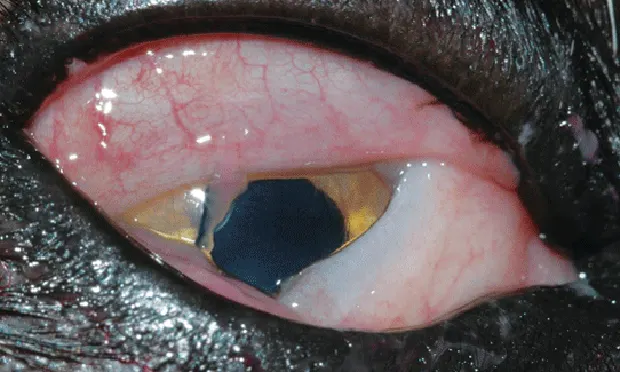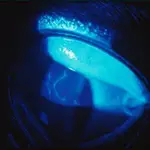Herpetic Keratoconjunctivitis in a Cat

Joshua, a 3-year-old castrated domestic short-haired cat, presented with a recrudescent upper respiratory and ocular infection.
HistoryThe patient, adopted from an animal shelter as a kitten, lived indoors with 3 other cats. Shortly after being adopted, Joshua developed an acute upper respiratory infection with sneezing, purulent nasal discharge, blepharospasm, and mucopurulent ocular discharge. Clinical signs resolved following a course of oral amoxicillin. After being involved in a recent move, Joshua developed a second upper respiratory and ocular infection.
Initial ExaminationBody condition score was 6/9. Respiratory rate was normal, with stertor present on exhalation. A small amount of serous discharge was present at the nares. Besides the ophthalmic examination, the remainder of the examination was within normal limits.
Ophthalmic ExaminationJoshua displayed moderate ocular discomfort bilaterally. Menace, dazzle, and direct and consensual pupillary light reflexes were normal in both eyes. Severe chemosis and moderate hyperemia of the palpebral and nictitans conjunctiva were present OU (Figure 1,above. Ophthalmic examination revealed severe chemosis and moderate hyperemia of the palpebral and nictitans conjunctiva in both eyes), as well as a small amount of mucopurulent discharge.
A Schirmer tear test revealed adequate tear production at 26 mm OD and 22 mm OS. There was fluorescein retention in a linear branching pattern adjacent to the limbus in the superficial cornea of both eyes (Figure 2, left. Fluorescein retention in a linear branching pattern in the superficial cornea was evident in both eyes). The anterior chamber and posterior segments were within normal limits.

Related Article: Corneal Disease in Cats
Laboratory DiagnosticsCBC, serum biochemical profile, and complete urinalysis findings were within normal limits. FeLV and FIV serology results were negative.
Initial TherapyThe history (stress) and clinical signs (conjunctivitis and dendritic corneal ulcers) were consistent with recrudescent latent feline herpesvirus 1 (FHV-1) infection. Initial therapy was aimed at controlling or preventing secondary bacterial infections, suppressing viral replication, and lowering Joshua’s stress levels. Topical 0.1% idoxuridine was administered OU q6–4h, followed by topical 1% chloramphenicol ophthalmic solution OU q8h with instructions to continue as directed until reexamination. Joshua was also treated with 0.5% topical cidofivir for 7 days; however, there was only minimal improvement in clinical signs.1-3 Once the family was settled in their new home, Joshua’s daily routine normalized.
Related Article: Chronic Keratoconjunctivitis in a Cat
Follow-UpTen days after therapy was initiated, Joshua’s chemosis had improved somewhat and his corneas no longer retained fluorescein stain. The conjunctivitis and ocular discharge persisted, however, and it became difficult for the owner to treat him. While he had previously been social and personable, Joshua would now disappear into inaccessible places and became reserved and nearly completely asocial. He appeared only at mealtimes.
Ask Yourself...What is a reasonable next step in therapy for Joshua?
A. Discontinue the topical antiviral therapy and begin topical neo-poly-dex (neomycin sulfate, polymyxin B sulfate, and dexamethasone ophthalmic solution); no need to reevaluate.B. Continue the topical medications and add oral l-lysine; reevaluate in 1 month.C. Discontinue topical medications and replace with oral famciclovir; reevaluate in 10 to 14 days.D. Administer an SC dose of methylprednisolone acetate; reevaluate in 1 month.E. Replace current topical therapy with triple antibiotic ointment and increase the frequency of administration; house the cat with naive kittens.
Correct Answer: CDiscontinue topical medications and replace with oral famciclovir; reevaluate in 10 to 14 days.
Related Article: Online Gallery: FHV-1 Images
Discussion1. PathogenesisFHV-1 infections account for a majority of feline conjunctivitis cases. The feline population, not the environment, is the reservoir of disease. Primary infection typically occurs in young cats and manifests with classic upper respiratory (sneezing, nasal discharge, malaise) and ocular (conjunctivitis, keratitis, ocular discharge) signs.
Primary infection is usually self-limiting, although establishment of lifelong latency of the virus within the trigeminal ganglia occurs in more than 80% of infected cats.4 Latent virus may be triggered by stress or illness, often following administration of corticosteroids. Chronic disease may result from cytolytic damage from active virus replication or from immune-mediated damage by inflammatory cells reacting to the presence of the virus.4
2. TreatmentTherapy is aimed at decreasing clinical signs of disease; complete clearance of the infection is not possible. With lytic disease (ulceration of conjunctival, corneal, and nasal epithelia; symblepharon), antiviral agents are indicated. Immunopathologic forms of disease (eg, stromal keratitis, chronic conjunctivitis) may require adding antiinflammatory therapy.
Famciclovir is an antiviral agent that is metabolized to penciclovir, a nucleoside deoxyguanosine analog with a similar mechanism of action to acyclovir.5 It is better tolerated in the short-term by most cats than acyclovir, neutropenia and renal dysfunction are occasionally reported with chronic use. It is typically administered to cats at 62.5 mg/cat PO q8–12h or 125 mg/cat PO q24h, and to kittens 15.625–31.25 mg/kitten PO q24h. Famciclovir can mitigate clinical signs and viral replication during an active bout of disease, especially in cats that are difficult to treat topically, have systemic disease, or have particularly severe clinical signs.6 A typical course of therapy is no longer than 2 to 3 weeks.
3. OutcomeAfter oral famciclovir therapy was initiated and the stress of topically administered drugs alleviated, clinical signs resolved and Joshua’s gregarious personality returned. On completion of a 3-week course of famciclovir medication, Joshua did not experience relapse until a year later, when stress associated with a neighbor’s pool construction triggered another bout of conjunctivitis.
Take-Home Messages
FHV-1 infection is common and lifelong latency is established in most cats. Reactivation of latent disease, although not common, may occur without obvious cause or clinical evidence.
Famciclovir as an adjunct to topical therapy may be particularly helpful in patients with severe herpetic disease, in patients with systemic disease (respiratory or dermatologic), and in patients that are difficult to treat topically.
Stress can be a major factor in the initiation and persistence of clinical signs associated with FHV-1 reactivation.
Hemogram and serum biochemical profiles should be monitored before and during oral antiviral therapy.